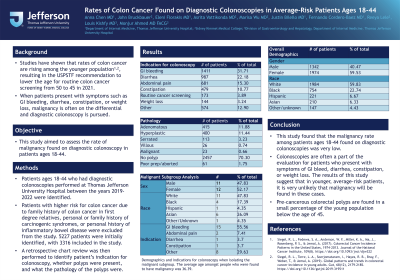Sunday Poster Session
Category: Colon
P0164 - Rates of Colon Cancer Found on Diagnostic Colonoscopies in Average-Risk Patients Ages 18-44
Sunday, October 22, 2023
3:30 PM - 7:00 PM PT
Location: Exhibit Hall

Has Audio

Anna Chen, MD
Thomas Jefferson University Hospital
Philadelphia, PA
Presenting Author(s)
Anna Chen, MD1, John Bruckbauer, BA1, Eleni Florakis, MD1, Asrita Vattikonda, BA1, Marisa Wu, BA1, Justin Bilello, MD1, Fernando Cordero-Baez, MD1, Reeya Lele, BA1, Louis Kishfy, MD1, Monjur Ahmed, MD, FACG2
1Thomas Jefferson University Hospital, Philadelphia, PA; 2Thomas Jefferson University, Philadelphia, PA
Introduction: Studies have shown that rates of colon cancer are rising among the younger population, resulting in the USPSTF recommendation to lower the age for routine colon cancer screening from 50 to 45 in 2021. When patients present with symptoms such as GI bleeding, diarrhea, constipation, or weight loss, malignancy is often on the differential and diagnostic colonoscopy is pursued. This study aimed to assess the rate of malignancy found on diagnostic colonoscopy in patients ages 18-44.
Methods: Patients ages 18-44 who had diagnostic colonoscopies performed at Thomas Jefferson University Hospital between the years 2019-2022 were identified. Patients with a higher risk for colon cancer due to a family history of colon cancer in first-degree relatives, a personal or family history of carcinogenic syndromes, or a personal history of inflammatory bowel disease were excluded from the study. A retrospective chart review was then performed to identify a patient’s indication for colonoscopy, whether polyps were present, and the pathology of the polyps.
Results: 5227 patients were initially identified, with 3316 included in the study after accounting for exclusion criteria. The most common indication for colonoscopy was GI bleeding (31.7%), followed by diarrhea (22.2%) and abdominal pain (15.3%). Only 23 patients (0.65%) were found to have malignancy during their colonoscopy. 2457 (70.3%) were found to have no polyp, 415 (11.9%) had tubular adenomas, 113 (3.2%) had serrated adenomas, 26 (0.74%) had villous/tubulovillous adenomas, and 61 (1.7%) had poor preps or aborted colonoscopies. 400 (11.4%) were found to have hyperplastic polyps. The cases of malignancy were fairly evenly distributed among patients ages 30-44, whereas 0 cases of malignancy were found in ages 18-24, and only 2 cases among ages 25-29. Among the cases of malignancy, 15 (55.6%) of the colonoscopies were done for GI bleeding, 2 were done for abdominal pain, 1 was done for diarrhea, 1 was done for constipation, and 8 were done for other reasons.
Discussion: This study found that the malignancy rate among patients ages 18-44 found on diagnostic colonoscopies was very low. Colonoscopies are often a part of the evaluation for patients who present with symptoms of GI bleed, diarrhea, constipation, or weight loss. The results of this study suggest that in younger, average-risk patients, it is very unlikely that malignancy will be found. Pre-cancerous colorectal polyps are found in a small percentage of the young population below the age of 45.
Disclosures:
Anna Chen, MD1, John Bruckbauer, BA1, Eleni Florakis, MD1, Asrita Vattikonda, BA1, Marisa Wu, BA1, Justin Bilello, MD1, Fernando Cordero-Baez, MD1, Reeya Lele, BA1, Louis Kishfy, MD1, Monjur Ahmed, MD, FACG2. P0164 - Rates of Colon Cancer Found on Diagnostic Colonoscopies in Average-Risk Patients Ages 18-44, ACG 2023 Annual Scientific Meeting Abstracts. Vancouver, BC, Canada: American College of Gastroenterology.
1Thomas Jefferson University Hospital, Philadelphia, PA; 2Thomas Jefferson University, Philadelphia, PA
Introduction: Studies have shown that rates of colon cancer are rising among the younger population, resulting in the USPSTF recommendation to lower the age for routine colon cancer screening from 50 to 45 in 2021. When patients present with symptoms such as GI bleeding, diarrhea, constipation, or weight loss, malignancy is often on the differential and diagnostic colonoscopy is pursued. This study aimed to assess the rate of malignancy found on diagnostic colonoscopy in patients ages 18-44.
Methods: Patients ages 18-44 who had diagnostic colonoscopies performed at Thomas Jefferson University Hospital between the years 2019-2022 were identified. Patients with a higher risk for colon cancer due to a family history of colon cancer in first-degree relatives, a personal or family history of carcinogenic syndromes, or a personal history of inflammatory bowel disease were excluded from the study. A retrospective chart review was then performed to identify a patient’s indication for colonoscopy, whether polyps were present, and the pathology of the polyps.
Results: 5227 patients were initially identified, with 3316 included in the study after accounting for exclusion criteria. The most common indication for colonoscopy was GI bleeding (31.7%), followed by diarrhea (22.2%) and abdominal pain (15.3%). Only 23 patients (0.65%) were found to have malignancy during their colonoscopy. 2457 (70.3%) were found to have no polyp, 415 (11.9%) had tubular adenomas, 113 (3.2%) had serrated adenomas, 26 (0.74%) had villous/tubulovillous adenomas, and 61 (1.7%) had poor preps or aborted colonoscopies. 400 (11.4%) were found to have hyperplastic polyps. The cases of malignancy were fairly evenly distributed among patients ages 30-44, whereas 0 cases of malignancy were found in ages 18-24, and only 2 cases among ages 25-29. Among the cases of malignancy, 15 (55.6%) of the colonoscopies were done for GI bleeding, 2 were done for abdominal pain, 1 was done for diarrhea, 1 was done for constipation, and 8 were done for other reasons.
Discussion: This study found that the malignancy rate among patients ages 18-44 found on diagnostic colonoscopies was very low. Colonoscopies are often a part of the evaluation for patients who present with symptoms of GI bleed, diarrhea, constipation, or weight loss. The results of this study suggest that in younger, average-risk patients, it is very unlikely that malignancy will be found. Pre-cancerous colorectal polyps are found in a small percentage of the young population below the age of 45.
Disclosures:
Anna Chen indicated no relevant financial relationships.
John Bruckbauer indicated no relevant financial relationships.
Eleni Florakis indicated no relevant financial relationships.
Asrita Vattikonda indicated no relevant financial relationships.
Marisa Wu indicated no relevant financial relationships.
Justin Bilello indicated no relevant financial relationships.
Fernando Cordero-Baez indicated no relevant financial relationships.
Reeya Lele indicated no relevant financial relationships.
Louis Kishfy indicated no relevant financial relationships.
Monjur Ahmed indicated no relevant financial relationships.
Anna Chen, MD1, John Bruckbauer, BA1, Eleni Florakis, MD1, Asrita Vattikonda, BA1, Marisa Wu, BA1, Justin Bilello, MD1, Fernando Cordero-Baez, MD1, Reeya Lele, BA1, Louis Kishfy, MD1, Monjur Ahmed, MD, FACG2. P0164 - Rates of Colon Cancer Found on Diagnostic Colonoscopies in Average-Risk Patients Ages 18-44, ACG 2023 Annual Scientific Meeting Abstracts. Vancouver, BC, Canada: American College of Gastroenterology.
